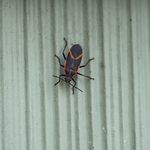13 Secrets Your Exterminator Wants You to Know

Repelling pests can be as simple as changing the light bulb above your porch.
Bedbugs are on the rise in North America
If you’re worried you have them, Mississauga-based entomologist Alice Sinia recommends checking your linens, mattress, mattress seams and headboard. Look for dried blood stains and red-brown fecal matter, which will both be about the size of a sesame seed. (Find out why you should never let your cat sleep in your bed.)
When you have trees or shrubs touching your house, an exterminator’s job becomes much harder
“Branches provide highways into the home for ants and rodents,” says Cindy Mannes, vice-president of public affairs for the National Pest Management Association.
After trimming back trees, look for other avenues of entry
Consider installing door sweeps and repair all screens, vents and openings in chimneys. Make sure to caulk or stuff steel wool around gaps made by utility lines, hoses and air conditioning units.
Keep things clean
“Pests are attracted to food, water and shelter,” says Mannes, “same as us.” Clean crumbs and spills immediately and scrub under fridges and stoves regularly. (Here’s how to clean absolutely everything in your kitchen.)
Put all the food in your pantry in plastic or glass containers with sealed lids
Critters such as mice, rats, moths, ants and weevils can easily eat through paper and cardboard.
Leave rodents to the professionals
An exterminator can determine where the pests are coming from and how best to trap them. If you have pets, exterminators will lay traps in a way that doesn’t endanger Fido—or his snout!
Ask about the treatments being used
Worried about harmful chemicals? Every homeowner has the right to ask for information about the treatments being used. If a pest control professional is unwilling or unable to provide details about the safety of the treatment, it’s time to move on, says Mannes.
When searching for an exterminator, get two or three quotes
The provider should be licensed and insured. They should also guarantee their treatments.
Clean up clutter
When an exterminator visits, they may need to access crawl spaces, attics and any other areas affected by the infestation. Make sure they don’t have to move stacks of boxes or an overfull utility shelf to get at what they need.
Don’t sweat what the neighbours will think
In a 2016 study conducted by the National Pest Management Association, one-third of respondents claimed that, if confronted with a pest control truck in the adjoining driveway, they’d feel their neighbour was being proactive with pest protection.
Save a sample of the offending insects
If you bring an exterminator out for ants and there are none to be found, the worker can’t do a proper treatment. Different species are removed in different ways. (Read up on the most disgusting house bugs—and how to get rid of them.)
Turn the lights off
White porch lights attract the flying insects that spiders eat, so that’s where the eight-legged critters build their webs. To reduce the number of spiders around your home, install yellow bug bulbs instead, and put your lights on a timer or switch to motion sensors.
Centipedes, millipedes, sowbugs and pillbugs thrive in damp environments
Reduce moisture and keep these pests at bay by removing leaf piles and grass clippings around your house and installing a dehumidifier.
Next, follow our healthy home checklist to eliminate potential hazards in every room.






